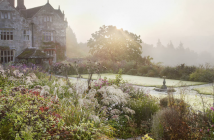Aah! Is there anything more glorious than an English garden when all is lush and verdant, the sun warming hearts as much as nature itself? It certainly feels so today here in Stratford-upon-Avon in beautiful Warwickshire.
Stratford is, of course, renowned for its connections to William Shakespeare – unarguably the most famous playwright in the world – born here in 1564, and was buried here following his death in 1616. Today, over four hundred years later, as well as his works, there is a vibrant interest in his birthplace, his homes, and gardens. Much of these have been brought under the guardianship of the Shakespeare Birthplace Trust whose aim is to promote the cultural, and intellectual, heritage that has been left to us.
I’m starting my tour at ‘New Place’, the site of Shakespeare’s family home for nineteen years until his death. Today, what was once the entrance to the front door is now the gateway to two and a half acres of landscaped gardens containing sculptures and artworks specifically designed to take the imagination back to the time in which Shakespeare lived.

Wandering through the sunken Knot Garden and the Arbour, amid marigolds and snapdragons, there is a wonderful scent of lavenders and herbs. A raised bed in the Golden Garden is planted with grasses and perennials and features thirty eight play pennants, representing each of Shakespeare’s plays. Beyond lies the Great Garden with its extensive lawn, herbaceous borders and best, to my mind, a wild bank at the perimeter, which contains plants mentioned in Shakespeare’s plays. “I know a bank where the wild thyme blows, where oxlips and the nodding violet grow”. Where better to spend a Midsummer Night’s Dream.
About a mile away, in the tiny hamlet of Shottery, is Anne Hathaway’s Cottage, the family home of Shakespeare’s wife. It is about as quintessentially English as anyone could hope to find. This five hundred and fifty year old thatched and Tudor timber-framed cottage, originally a farmhouse, nestles within nine acres of glorious gardens, orchards and meadows. All have been restored and planted with the flowers, shrubs, herbs and trees that would have been popular in Shakespeare’s time. They were certainly known to him as there are many references to such in his works; quince, mulberry, eglantine, myrtle, peach and plum are amongst the forty trees in the orchard. Grasses and wildflowers abound in the meadow while the cottage garden flaunts colourful perennial borders amongst the untamed shrubs and ornamental fruit plants.

Despite the inevitable flow of tourists here, this is a wonderfully peaceful and evocative setting. How easy it is to imagine Shakespeare passing through the meadows and crossing the brook on his way to woo his future wife, and perhaps drawing inspiration for his writings. “There is a willow grows aslant the brook, that shows his hoar leaves in the glassy stream,” as Gertrude states in Hamlet.
Feeling quite inspired myself with horticultural visions far beyond my capabilities I visit Ragley Hall just half an hour away. A fine and imposing Palladian mansion built in 1680 and home to the Marquess of Hertford. The gardens here are a wonderful blend of the formal and the more natural. Ten hectares were enclosed from the greater park to create a pleasure garden with meandering paths through the trees and shrubs and glimpses of the formal gardens and their riot of colours.
Seeing this vast expanse of planting I have to wonder as to the amount of gardeners that must be required. Four is the surprising answer, perhaps assisted by the occasional volunteer or horticultural student. I’m afforded the opportunity to sip Pimms on the terrace with Lord Hertford and admire these formal gardens on the downward slope nearest to the house. Beyond lies a vision of sprawling, and very green, parkland.

Gazing over another one hundred and seventy hectares of sweeping, undulating scenery, while the peacocks flaunt their feathers in the sun, and the peace is almost tangible, there is, to me, a great sense of the very Englishness of it all. The parklands here were designed by the inimitable ‘Capability’ Brown and a wonderful feature is the old grassed track where horse-drawn coaches made their entrance and slowly progressed towards the house over the rise and fall of the land.
Brown also designed the parklands at nearby Compton Verney. Here, a magnificent mansion in Neoclassical style – used today as an art gallery – sits amidst Brown’s vision of a ‘minimalist landscape’. The old formal Baroque-style gardens were replaced with grassland and over two and a half thousand saplings of oak, cedar and ash. His thought was to plant the more exotic trees such as European Limes and Cedars of Lebanon close to the house and then move out across the landscape to native trees and wildflower meadows.
Garden buildings were moved and the old ponds made into a single expanse of water. Views from the house were thus opened up, and the approaching visitor could glimpse the lake, the house, the meadows, and the enticing wooded copses in a sequence of images. Today there is a wonderful serenity as one strolls around the park. Brown’s minimalist vision back in the C18th has been beautifully restored and maintained by a dedicated team of gardeners.

In contrast to the sweeping vistas across 120 acres at Compton Verney I find the tiny, five hundred year-old garden hidden within the walls of the Lord Leycester Hospital in neighbouring Warwick. Originally the Guildhall, back in 1348, it was adapted in Tudor times to house disabled and wounded warriors and provides the same facilities today to deserving servicemen.
Hidden behind the Tudor timbering of this lovely building is the tiny garden – an absolute oasis of colour and scent. A small thatched summer house sits amongst the garden and provides a tranquil and lovely place for contemplation. I take a seat there and think how the gardens I have seen, in their various forms and designs, have developed according to fashion, style and necessity over the centuries.
Back at my hotel, the charming and intimate Arden House just minutes from Shakespeare’s New Place, they have a delightful custom of Gin’ O’ Clock at around five in the afternoon. As I sip and relax, in their own pleasant garden surrounds, I find myself reflecting on how much watering must be done to keep all the gardens nourished. But this is an English summer after all and, as everyone moves inside, the rain starts to fall…
For more information on all things Shakespeare, including details of summer activities, planning your visit, and even the Shakespeare Film Festival 2017, visit www.shakespeare.org.uk. For more information on the gardens and the area, including Stratford Butterfly Farm and Hill Close Gardens in Warwick, please visit www.shakespeares-england.co.uk.




